Digital Exhibition
Kathleen Wentrack
Mary Beth Edelson: Various Exhibition Installations
Kathleen Wentrack
Oct 24, 2019
The collages most often associated with Edelson are the well-known posters of the 1970s—such as “Some Living American Women Artists/Last Supper” (1971-1972) and “Death of the Patriarchy/A.I.R.” (1976)—each of which focuses on a specific theme and works to overtly challenge the patriarchy as they assert women’s agency.

The genesis of the wall collages in contrast was one of happenstance as they evolved out of the scraps leftover from the poster production. The wall collages were only exhibited for the first time in 1998 at the Agency Gallery in London, twenty-five years after the beginning of their production. The Agency Gallery selected works for a small retrospective and in the process came upon the wall collages forming Ono Flakes of 1973. A selection of Ono Flakes was hung in a loose configuration directly on the wall surrounding the collage posters in their gallery. This early collage piece devoted to Yoko Ono is made up of multiple identical smaller pieces or flakes arranged to appear as if they are gracefully falling to the ground like snowflakes.
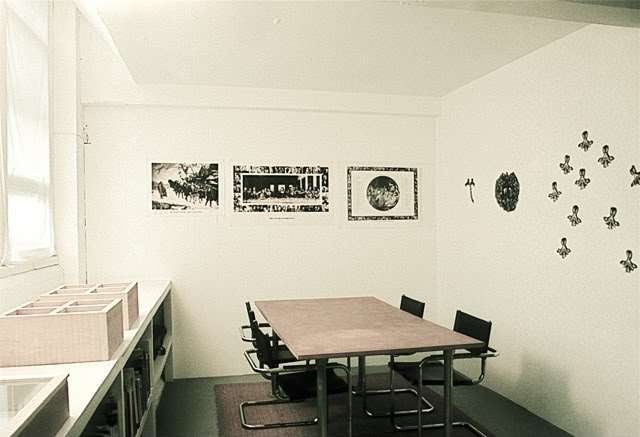
The exact image of Ono in these collages also appears in the collage poster, “Some Living American Women Artists/Last Supper”. In the five posters, the artist insisted on an alternative vision of society that included women in positions of power. Most of the photographs Edelson used were from her archives and ones that she herself took. In this first of the series Edelson collected photographs of living women artists and collaged their faces over Jesus and his disciples on a reproduction of Leonardo da Vinci’s “Last Supper” of 1498. The “apostles” now include Lynda Benglis, Helen Frankenthaler, June Wayne, Alma Thomas, Lee Krasner, Nancy Graves, Elaine de Kooning, Louise Nevelson, M.C. Richards, Louise Bourgeois, Lila Katzen, and Yoko Ono with Georgia O’Keeffe as the head figure at the table. Additional faces of female artists frame the main image, and all are identified by name on the poster with small pieces of typed paper glued in place adding an additional sixty-nine women (Edelson, 2002, 32b-32e).

The offset reproduction of the first poster, as well as the following four posters was affordable and widely distributed for sale at feminist conferences and panels, on college campuses, and in galleries in the U.S. and abroad, as well as having a vast ongoing exhibition record. Additionally, the “Last Supper” poster presented an unexpected utilitarian function for curators, educators, and art writers because it provided a list of women artists as well as visual identification which functioned as useful reminders of artists to consider for inclusion. The utilitarian aspect also carried on into using the posters to raise money for non-profit feminist enterprises as well as museum bookstores during feminist exhibitions. The posters became iconic images of the 1970s feminist art movement.

Edelson’s wall collages have only been exhibited on any scale in the U.S. since 2010, and recent large installations were created for “Mary Beth Edelson: A Well Lived Life” (2006) at the Malmö Konstmuseum in Sweden and the “Greater New York” exhibition held at MoMA PS1 in 2015. The web-like structure of the individual collages extends to how the works are displayed collectively.
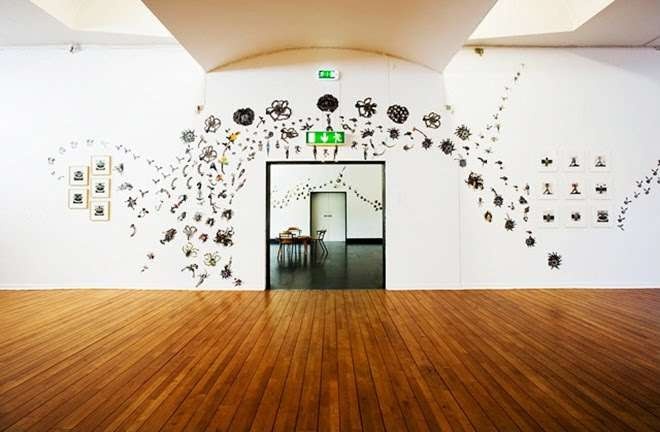
The collages are often intertwined with framed works of drawings or photographs usually from a private performance whose images may also be in the collages. The wall collages that surround these works may be selected because they relate to, expand or speak to this particular performative work. This interaction makes for a striking contrast between the static, framed photograph and the twisting dynamic forms of the collages.
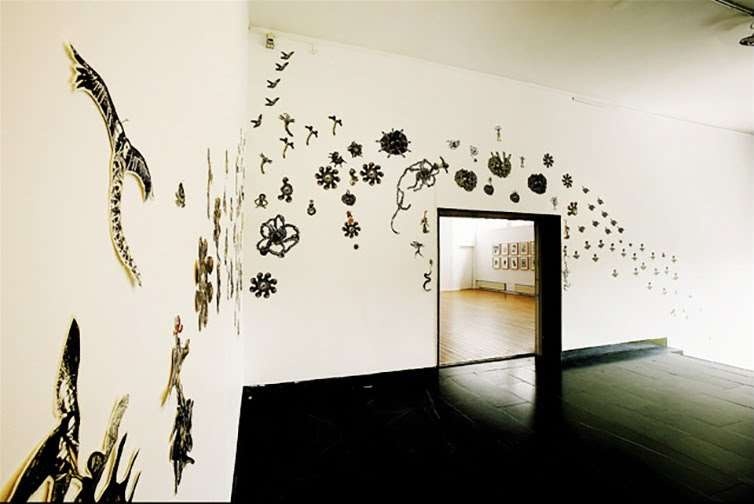
Edelson described the historical intention of the wall collage project: “An important aspect of these collages is commemoration. I want to honor these women who gave so much of their time in the 70s to building the feminist movement, and stuck with it—making it happen. They acknowledge that we had a revolution in the 70s and we won the revolution and it affected the whole world and it’s still affecting the whole world…” (Edelson, 2008)

An important exhibition of Edelson’s work was held in 2013 at the Accola Griefen Gallery in New York because it highlighted her collaborative work alongside the rich depth of the materials in her archives now in the Fales Library and Special Collections and her unique artist books, rather than well-known pieces such as the private ritual performative photographs.
This first installation shot at the 2013 Accola Griefen Gallery exhibition focuses on her earth work drawings and the important historical materials that Edelson collected over the years and maintained in her archives as seen on the table.
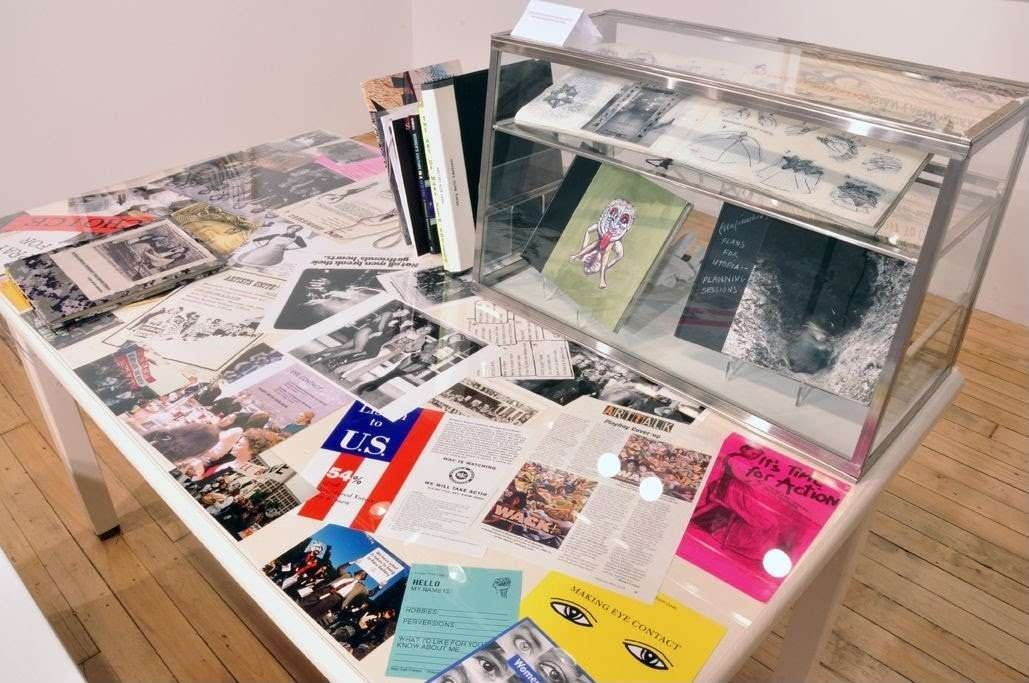
The second closer image focuses on exhibition announcements, collaborative projects and actions, Edelson’s photographs of protests, and documents relating to collaborations among women artists. The glass case shows several of Edelson’s artist books.
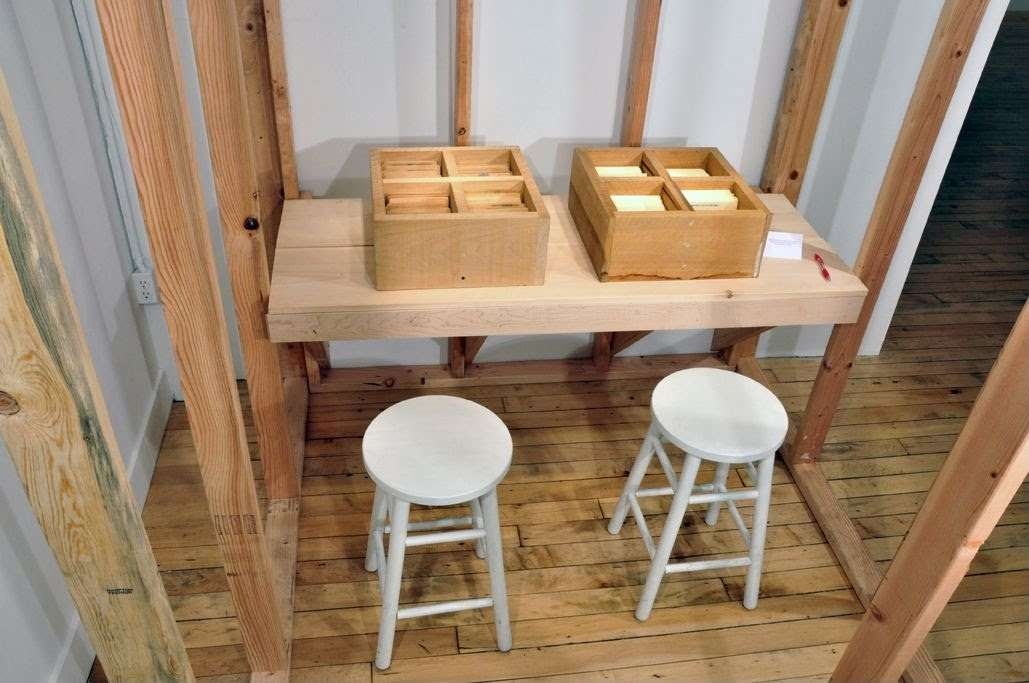
The collaborative work included group performances with fellow artists and others held with students at various colleges campuses, alongside a selection from her “Story Gathering Boxes” (begun 1972) in which the artist invites the exhibition viewer to become an active participant. These boxes are made from thick pine with four square sections that each hold manila-colored cards with a question stamped across the top. Each box and set of questions relate to specific themes with which the artist engages the viewer, who can choose to become an active participant in the work by handwriting a response to the prompts. Boxes include “New Beginning” (1989) with the question “Make up a new beginning” on the card, Childhood (1995) with the questions “What was it like to be a girl?” and “What was it like to be a boy?,” and Domestic Violence (1995) with the prompt “Stories about domestic violence.” The questions may seem neutral but at the same time elicit strong responses in the participants. Edelson was one of the earliest artists to engage in this participatory method of artistic production.

Edelson’s artist books are now in the Fales Library and Special Collections along with the archival material explicating her prolific engagement with feminist artists and actions since the 1970s.
Written by Dr. Kathleen Wentrack
© 2019 Kathleen Wentrack
Kathleen Wentrack, PhD, is a Professor of Art History at The City University of New York, Queensborough CC and the editor of the forthcoming book “Collaboration, Empowerment, Change: Women’s Art Collectives.” She recently published “1970s Feminist Practice as Heterotopian: The Stichting Vrouwen in de Beeldende Kunst and the Schule für kreativen Feminismus,” in “All Women Art Spaces in the Long 1970s” edited by Agata Jakubowska and Katy Deepwell (Liverpool University Press, 2018). She is a contributing editor to Art History Teaching Resources and Art History Pedagogy and Practice and a co-coordinator of The Feminist Art Project in New York City.
Produced by Erica Galluscio
Photography of studio space provided by Kolin Mendez Photography
Accola Griefen Fine Art exhibition photos courtesy of Accola Griefen Fine Art: Rob van Erve
Images of “Goddess Tribe” installation courtesy of David Lewis New York
Select Bibliography
Buszek, Maria Elena. “Mothers and Daughters, Sluts and Goddesses: Mary Beth Edelson and Annie Sprinkle.” In: It’s Time for Action (There’s No Option). About Feminism. Ed. Heike Munder. Zurich: Migros Museum für Gegenwartskunst and JRP/Ringier, 2007, 228-61.
Edelson, Mary Beth. The Art of Mary Beth Edelson. New York: Seven Cycles, 2002.
Edelson, Mary Beth. Firsthand: Photographs by Mary Beth Edelson, 1973-1993 and Shooter Series. Essay by Jan Avgikos, “No Reverse Gear.” Mary Beth Edelson: New York, 1993.
Edelson, Mary Beth. Interview with Kathleen Wentrack. New York, 12 September 2008.
Edelson, Mary Beth. “Male Grazing: An Open Letter to Thomas McEvilley.” In: Feminism-Art-Theory: An Anthology, 1968-2000.” Ed. Hilary Robinson. Oxford: Blackwell, 2001, 592-94. First published as “Objections of a ‘Goddess Artist:’ An open Letter to Thomas McEvilley.” New Art Examiner 16, No. 8 (April 1989): 34-38.
Edelson, Mary Beth. “Pilgrimage/See for Yourself: A Journey to a Neolithic Goddess Cave, 1977. Grapceva, Hvar Island Yugoslavia.” Heresies: A Feminist Publication of Art and Politics #5, Spring 1978: 96-99.
Edelson. Mary Beth. Seven Cycles: Public Rituals. With an Introduction by Lucy R. Lippard.” New York: Mary Beth Edelson, 1980.
Edelson. Mary Beth. Shape Shifter: Seven Mediums. New York: Mary Beth Edelson, 1990.
Edelson. Mary Beth. “Success Has 1,000 Mothers: Art and Activism from Mary Beth Edelson’s Point of View.” In: Women’s Culture in a New Era: A Feminist Revolution? Ed. Gayle Kimball. Lanham, Maryland: The Scarecrow Press, 2005, 27-60..
Freitag, Barbara. Sheela-Na-Gigs: Unraveling an Enigma. London: Routledge, 2004
Gimbutas, Marija. Gods and Goddess of Old Europe, 7000 to 3500 BC/Myths, Legends, and Cult Images. Berkeley: University of California Press, 1974.
Griefen, Kat. “Considering Mary Beth Edelson’s Some Living American Women Artists.” The Brooklyn Rail, March 2019, 38-9.
Höglinger, Nora. “Mary Beth Edelson: “The Goddess is Us.” In: Feminist Avant-Garde: Art of the 1970s, The Sammlung Verbund Collection, Vienna. Ed. Gabriele Schor. Munich: Prestel Verlag, 2016, 120-25.
Mesopotamian Gods and Goddesses. Ed. Vincent Hale and Vincent Croce. New York: Britannica Educational Publishing and Rosen Publishing Group, 2014.
Stone, Merlin. When God Was a Woman. New York: Dial Press, 1976.
Wack! Art and the Feminist Revolution. Ed. Lisa Gabrielle Mark. Los Angeles: The Museum of Contemporary Art, 2007.
Winifred Milius Lubell, The Metamorphosis of Baubo: Myths of Women’s Sexual Energy, Nashville and London: Vanderbilt University Press, 1994

